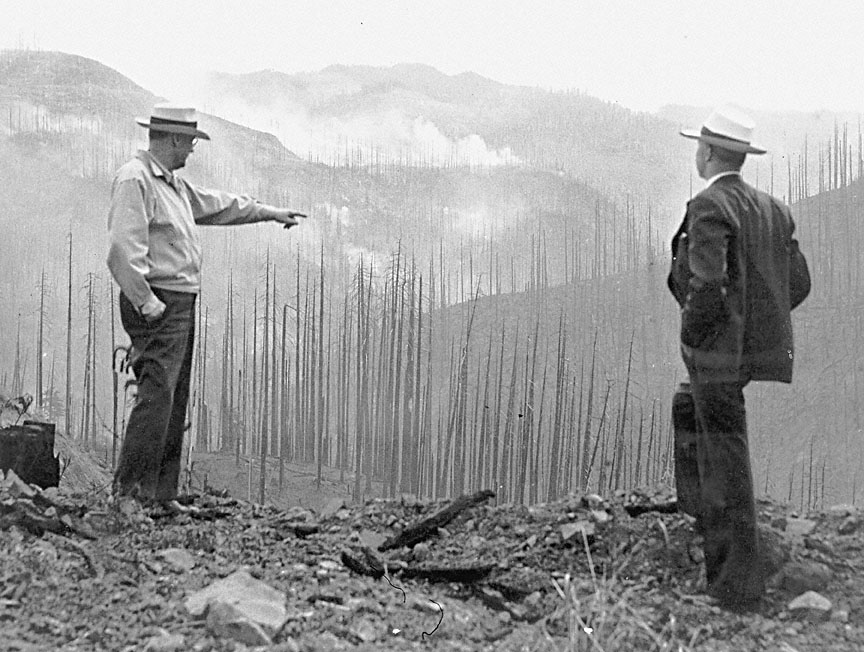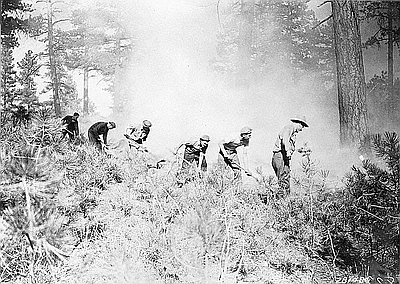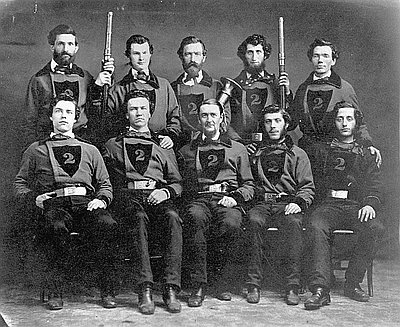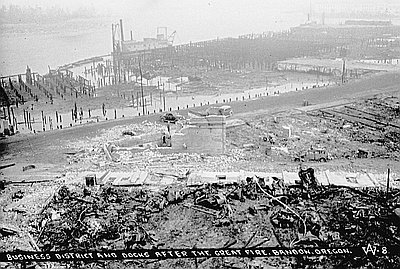This photograph was taken in July 1945. It shows Governor Earl Snell looking on as State Forester Nelson Rogers describes the 5,000-acre Salmonberry fire. This blaze was one of several fires that burned over the area known as the Tillamook Burn.
From 1933 to 1951 four large fires swept over the northern part of Oregon’s Coast Range. The first major fire hit in August 1933. This fire, the largest of the four blazes, is generally attributed to a logging operation in Gales Creek Canyon, though a second blaze may have already been underway deeper in the forest. Whatever the ignition source, the forest quickly exploded into a conflagration the likes of which Oregonians had never before witnessed. Thousands of firefighters, loggers, and Civilian Conservation Corps workers fought in vain to control the blaze, which swept over more than 260,000 acres of prime timberland in the space of two weeks.
The next three fires returned at regular six-year intervals, suggesting to some Oregonians that the area was cursed. Like the first fire, the 1939 blaze, which covered nearly 209,700 acres, was probably caused by a logging operation, as was the next fire, which occurred in 1945. This blaze consisted of two separate fires, the Wilson River fire and the smaller Salmonberry fire, the latter of which is shown in the photograph above. Together they burned more than 180,000 acres. The final major fire to sweep across the Tillamook Burn came in 1951. Smaller than the previous fires, it still managed to burn more than 32,000 acres before it was brought under control.
All told, nearly 355,000 acres of prime timberland were burnt over in the course of eighteen years. It was a serious blow to the state's economy, then largely dependent on timber. Trees containing an estimated 13 billion board-feet were killed in the four blazes, enough to build more than a million five-room houses, though most of the burned timber was eventually salvaged.
Since the vast majority of the potential seed trees had been killed by fire or cut down in the ensuing salvage operations, the state undertook a massive replanting effort that would eventually span more than two decades. Beginning with a modest roadside beautification program in 1944, the effort blossomed into a large-scale replanting program after voters approved a $10.8 million bond measure in 1948. It was the largest forest rehabilitation project ever attempted in the United States. The state ended up acquiring most of the Tillamook Burn, and in 1973 the area was designated the Tillamook State Forest.
Further Reading:
Lucia, Ellis. Tillamook Burn Country: A Pictorial History. Caldwell, Idaho, 1983.
Wells, Gail. The Tillamook: A Created Forest Comes of Age. Corvallis, Oreg., 1999.
Written by Cain Allen, © Oregon Historical Society, 2006.



